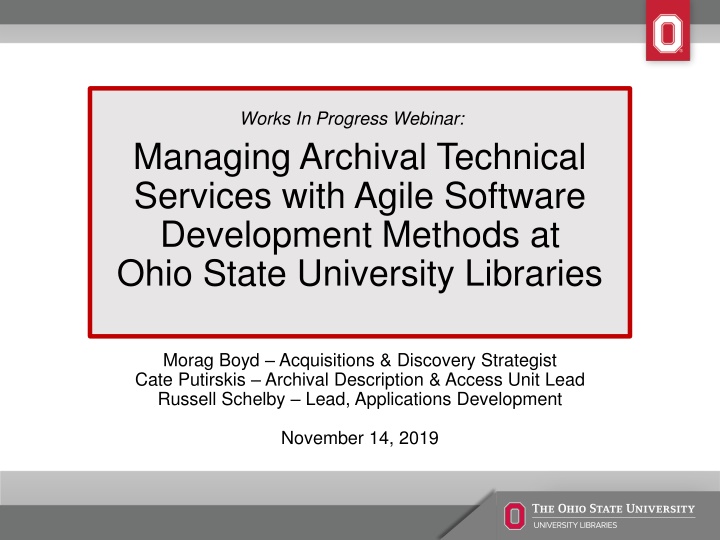
Managing Archival Technical Services with Agile Methods at OSU Libraries
Explore how Ohio State University Libraries are using Agile software development methods to manage archival technical services efficiently. Learn about their strategic goals, challenges, and the implementation of a central processing program. Discover the gap in decentralized archival management and the transformation towards a more cohesive approach. Gain insights into the diverse range of tasks handled by the Archival Description & Access Unit.
Download Presentation

Please find below an Image/Link to download the presentation.
The content on the website is provided AS IS for your information and personal use only. It may not be sold, licensed, or shared on other websites without obtaining consent from the author. If you encounter any issues during the download, it is possible that the publisher has removed the file from their server.
You are allowed to download the files provided on this website for personal or commercial use, subject to the condition that they are used lawfully. All files are the property of their respective owners.
The content on the website is provided AS IS for your information and personal use only. It may not be sold, licensed, or shared on other websites without obtaining consent from the author.
E N D
Presentation Transcript
Works In Progress Webinar: Managing Archival Technical Services with Agile Software Development Methods at Ohio State University Libraries Morag Boyd Acquisitions & Discovery Strategist Cate Putirskis Archival Description & Access Unit Lead Russell Schelby Lead, Applications Development November 14, 2019
Setting the Stage The Ohio State University Libraries Seven special collections in three buildings 2011-2016 Strategic Plan Position distinctive collections, spaces and services in user's pathways, in both physical and virtual environments, to promote intellectual inquiry and encourage lifelong learning Increase the scale and scope of distinctive and digital collections and enhance access to and usage of these materials to support research and anytime, anywhere learning Creation of one central Processing Program
Goals All collections discoverable by researchers Consolidation to supported tool set Standards based description that could interoperate across discovery and management tools Minimum description for everything All collection material managed appropriately
The Gap History of decentralized archival and artifact management Several systems and standards/practices Often multiple tools within one unit Some data sources had no public access Balancing needs of multiple collections units and curators Unprocessed collections High volume of collecting Implementation of off-site storage Limited resources
Archival Technical Services at OSU Libraries Accessioning (including coordinating transport of materials to us & completing legal and gift paperwork) Enhancement work (including processing and other iterative improvements, corrections/updates requests, etc.) Exposing backlogs (creating/migrating description for legacy holdings, remediating discrepancies across data sources, etc.) Logistics (shelving and storage management, archival CMS management, online description publishing & maintenance, conservation/housing activities, ordering archival supplies, etc.) Policy Management (writing and maintaining manuals, documentation, and workflows; archival training for colleagues, etc.)
Archival Description & Access Unit Challenges: Inconsistent staffing Staff generally new to the profession Lots of dependency on student support, etc. New staff + new department = continual work in progress But also: opportunity to be experimental in our solutions
Similar Situations Project vs. Maintenance Disparate Clients Changing Priorities Large Backlogs Uncertain Effort Archival Description & Application Development
Agile, Briefly. Software Method Method Software Agile Versioned Software Waterfall Well-Defined Product This Photo by Unknown author is licensed under CC BY-SA.
Agile, Briefly. Software Method Method Scrum vs Kanban Software Sprints: limited period of work Scrum vs Kanban Projects ==> Scrum Tasks ==> Kanban
Agile, Briefly. Software Method Scrum vs Kanban Kanban Agile Roles Software Method Scrum vs Scrum Master or Leader of Boards Service Owner or Board Leader Agile Roles Product Owner or Stakeholders
Agile, Briefly. Software Method Scrum vs Kanban Agile Roles Project As Cake
Why Agile for Archival Work? Value of assigning People to Work instead of Work to People Most value sooner: priorities are set together with partners; work is done when good enough because iteration is part of the workflow Agile is the workflow realization of MPLP iteration concepts
Implementation: First Attempt Scrum Things tried: Sprints/sprint planning Planning Poker Daily stand-ups Sprint reviews Bi-weekly report outs to partners
Implementation: Second Attempt Kanban Things kept from Scrum: Sprints kind of Daily stands-ups Bi-weekly reporting out Things added: Functional area/project boards WIP (Works in Progress) limits Tracking Progress/Blocked status
Implementation: Quality Control Kanban emphasizes a strong QC (or, QA Quality Assurance) process QC is time well spent: Catches more errors before work is considered done Builds individual knowledge Builds collaborative skills Finds shared misunderstandings quickly
Tools White Boards Bulletin Boards This Photo by Unknown author is licensed under CC BY-SA.
Tools White Boards Bulletin Boards Software Boards
Tools White Boards Bulletin Boards Software Boards Scaling
Results Productivity gains More projects completed sooner People spending time more effectively Transparency Communication Periodic sprint reports to wide range of stakeholders
Results: Partner Relationship Special Collections units gained Clearer understanding of what is being done Demonstrated improved productivity Understanding of a range of activities and priorities across all units
Results: Administration and Planning Projections of work and resources to achieve goals Enabled term and permanent staff positions Leveraging expertise and collaboration towards aspirational future state Identify and eliminate duplicative work
https://library.osu.edu/strategic-directions/current-initiatives/agile-processing-for-special-collectionshttps://library.osu.edu/strategic-directions/current-initiatives/agile-processing-for-special-collections
Archivists: Is Agile Worth It? Agile looks different for everyone, but has something for everyone Can improve transparency and communication Fairly easy to learn Improves output, decreases time from start to finish of most projects
Building Relationships Time Investment Talk About Projects Talk About Not-Projects Complex Collaboration
Thank You! Questions? Morag Boyd boyd.402@osu.edu Cate Putirskis putirskis.1@osu.edu Russell Schelby schelby.1@osu.edu
